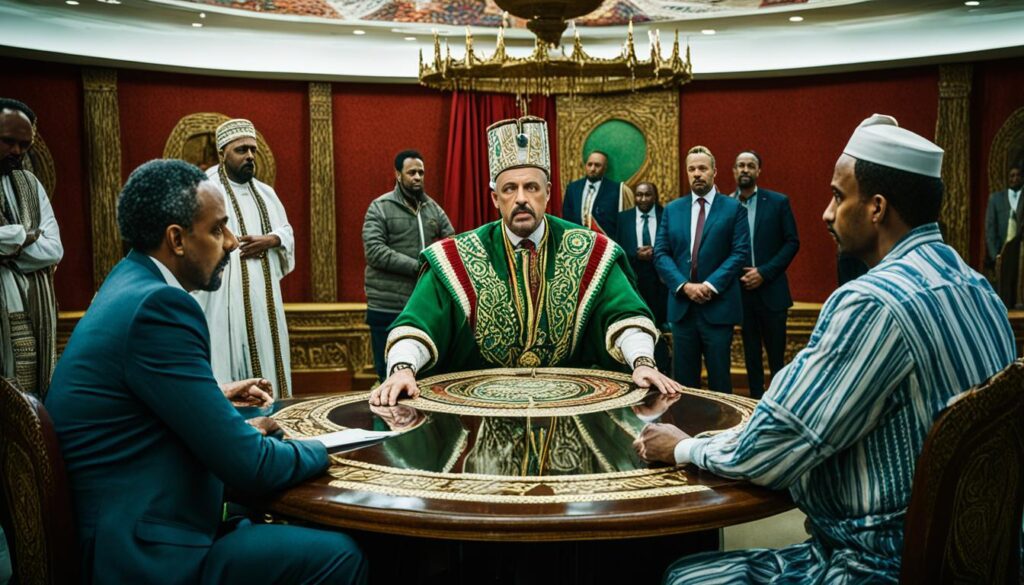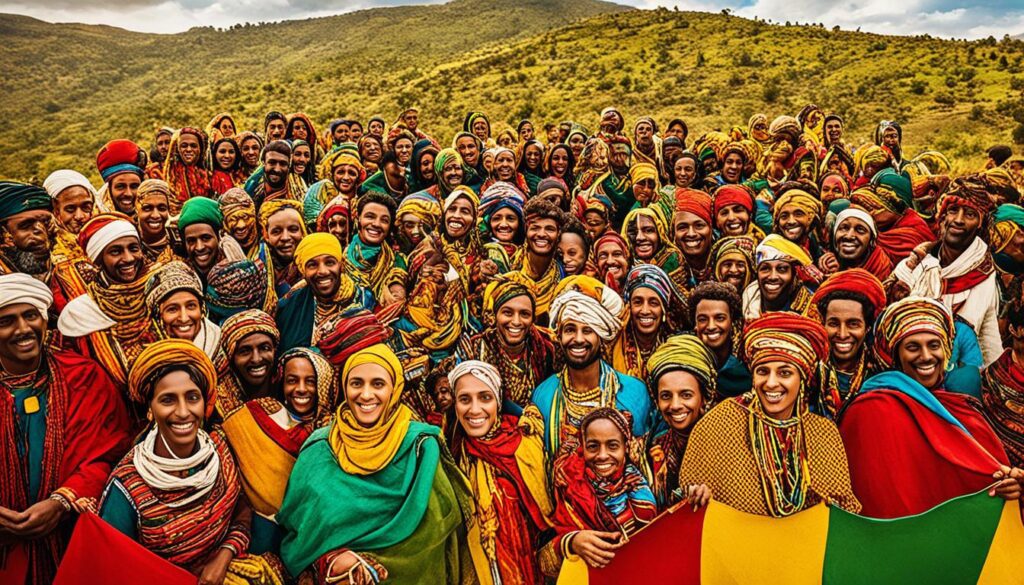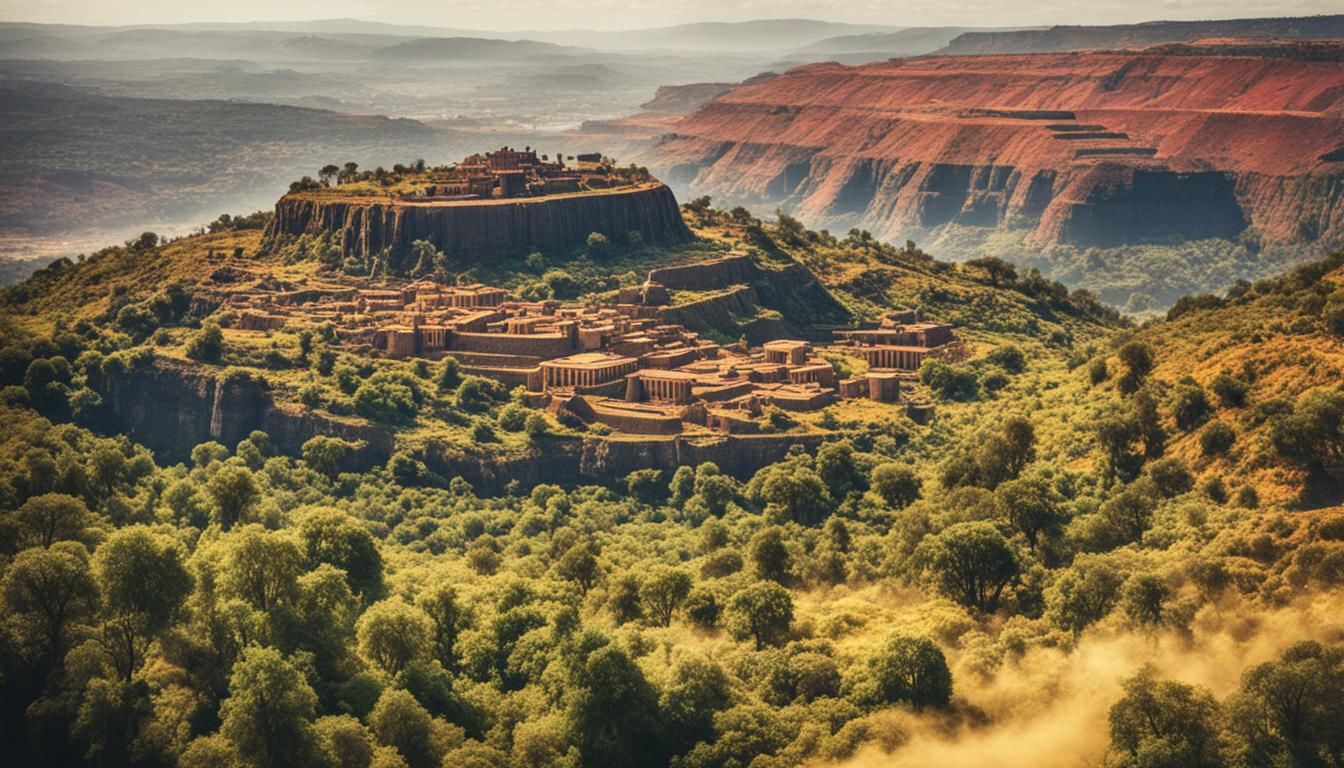Is Ethiopia a Country?
Did you know that Ethiopia, located in the Horn of Africa, has a land area of 1,112,000 square kilometers (429,000 square miles)? This makes it the 10th largest country in Africa and one of the most geographically significant nations on the continent. But the question remains, is Ethiopia truly a country?
Let’s delve into the diverse culture, rich history, and unique political system of Ethiopia to understand its status as a sovereign nation.
Key Takeaways:
- Ethiopia is a fully independent and recognized nation, with membership in the United Nations and African Union.
- It has a diverse geography, sharing borders with Eritrea, Djibouti, Somalia, Kenya, South Sudan, and Sudan.
- Ethiopia operates under a federal parliamentary republic system of government.
- The country is home to over 80 different ethnic groups and boasts a linguistic diversity reflective of its cultural heritage.
- Religion plays a significant role in Ethiopian society, with Christianity and Islam being the two major religions.
Ethiopian Geography and Location
Ethiopia, a horn of Africa nation, is strategically located in a region known for its unique geography and diverse landscapes. Situated between the latitudes 3° and 14.8° North and the longitudes 33° and 48° East, Ethiopia shares borders with several neighboring countries.
“Ethiopia is like a bridge connecting different parts of Africa,” says Dr. Abiy Ahmed, the Prime Minister of Ethiopia.
The countries that border Ethiopia are:
- Eritrea to the north
- Djibouti to the northeast
- Somalia to the east and southeast
- Kenya to the south
- South Sudan to the west
- Sudan to the northwest
With its central plateau, Ethiopia boasts an average elevation of 2,000 to 3,000 meters. This high altitude region is home to numerous towering mountains, with some reaching heights of over 4,000 meters. The majestic Ethiopian highlands, Rift Valley Lakes, and the Great Rift Valley are prominent geographic features that captivate nature enthusiasts and adventurers alike.
A Land of Geological Marvels
The diverse Ethiopian landscape consists of volcanic peaks, deep gorges, vast savannahs, and lush green highlands. These natural wonders make Ethiopia a paradise for outdoor activities such as hiking, wildlife spotting, and bird-watching.
“Ethiopia’s geography is a testament to the breathtaking beauty of our planet,” shares Dr. Arega Yirdaw, an Ethiopian geologist.
Ethiopian Government and Political System

In Ethiopia, the government operates under a federal parliamentary republic system. This system ensures a balance of power between the executive, legislative, and judicial branches. Let’s take a closer look at how the Ethiopian government functions.
The head of state in Ethiopia is the President, currently Sahle-Work Zewde. The President represents the country at the international level and performs ceremonial duties. On the other hand, the head of government is the Prime Minister, currently Abiy Ahmed. The Prime Minister leads the executive branch and is responsible for implementing government policies and decisions.
The Prime Minister is appointed by the President and serves as the chief executive. This appointment is based on the majority representation in the House of Peoples’ Representatives, the lower house of the Federal Parliamentary Assembly.
The legislature in Ethiopia consists of two houses: the House of Federation and the House of Peoples’ Representatives. The House of Federation, which represents different ethnic groups and regions, safeguards the rights and interests of all states within the country. The House of Peoples’ Representatives, elected through a popular vote, enacts laws and oversees the executive branch.
The judiciary in Ethiopia is independent and led by the Chief Justice of the Federal Supreme Court, currently Tewodros Mihret. The judiciary ensures the rule of law and protects the rights of individuals under the constitution.
As a multi-party democracy, Ethiopia allows the existence of different political parties. The ruling party in Ethiopia is the Ethiopian People’s Revolutionary Democratic Front (EPRDF), which has been in power since 1991. Political parties play a crucial role in advocating for their respective ideologies and participating in the democratic process.
“The Ethiopian government’s federal parliamentary republic system aims to ensure democratic governance and representation of diverse voices across the country.”
Ethiopian Government Structure
To provide a visual representation of the Ethiopian government structure, here is a table outlining the key positions and branches:
| Branch | Position | Current Office Holder |
|---|---|---|
| Executive | Head of State | Sahle-Work Zewde |
| Head of Government | Abiy Ahmed | |
| Legislative | Upper House | House of Federation |
| Legislative | Lower House | House of Peoples’ Representatives |
| Judicial | Chief Justice of the Federal Supreme Court | Tewodros Mihret |
Through its federal parliamentary republic system, Ethiopia aims to ensure democratic governance, representation of diverse voices, and the protection of individual rights. The government structure reflects a commitment to balance and accountability within the political system.
Ethnic and Linguistic Diversity in Ethiopia

Ethiopia is renowned for its remarkable ethnic and linguistic diversity, enriching the cultural tapestry of the country. With over 80 different ethnic groups, Ethiopia is a true mosaic of traditions, customs, and languages. Each group contributes to the vibrant cultural heritage that defines the nation.
The 2007 census revealed the largest ethnic groups in Ethiopia. Let’s take a look at some of them:
1. Oromo (34.5%): The Oromo people are the largest ethnic group in Ethiopia, residing primarily in the Oromia region. They have a distinct language and a rich cultural heritage.
2. Amhara (26.9%): The Amhara people have a significant presence in the northern and central parts of Ethiopia. They have played a vital role in the country’s history and are known for their Amharic language.
3. Somali (8.2%): The Somali people predominantly reside in the Somali region of Ethiopia. They have their own language and traditional practices.
4. Tigrayan (5.1%): The Tigrayan people are mainly found in the Tigray region of Ethiopia. They speak Tigrinya and have a profound cultural heritage.
5. Sidama (3.0%): The Sidama people reside primarily in the Southern Nations, Nationalities, and Peoples’ Region (SNNPR). They have their own language and unique customs.
6. Gurage (2.5%): The Gurage people are concentrated in the Gurage Zone of the SNNPR. They have a distinctive language and a rich agricultural tradition.
7. Welayta (2.3%): The Welayta people primarily reside in the Southern Nations, Nationalities, and Peoples’ Region. They have their own language and cultural practices.
8. Hadiya (1.7%): The Hadiya people are mainly concentrated in the Hadiya Zone of the SNNPR. They have their own language and contribute to the diverse heritage of Ethiopia.
9. Afar (1.7%): The Afar people predominantly reside in the Afar Region of Ethiopia. They have their own language and a rich nomadic culture rooted in the region’s harsh environment.
10. Gamo (1.5%): The Gamo people primarily reside in the Gamo Zone of the SNNPR. They have their own language and cultural customs that distinguish them within Ethiopia.
Alongside these major ethnic groups, numerous other ethnicities contribute to the country’s diversity and cultural vibrancy.
In addition to the multitude of ethnicities, Ethiopia boasts a rich linguistic landscape. While Amharic serves as the official language, several other languages are widely spoken throughout the country. Oromo, Somali, and Tigrinya are among the prominent languages, reflecting the diversity and heritage of different communities.
The image above showcases the rich diversity of Ethiopia’s ethnic groups and languages. This visual representation offers a glimpse into the intricate tapestry of cultures that contribute to the fabric of Ethiopian society.
Religion in Ethiopia
Religion holds great significance in Ethiopian society, shaping its cultural fabric and social dynamics. With a diverse religious landscape, Ethiopia is known for its adherence to Christianity, particularly the Ethiopian Orthodox Tewahedo Church, as well as Islam and other traditional faiths. Let’s explore the religious composition of Ethiopia:
Ethiopian Orthodox Christianity
Ethiopian Orthodox Christianity is deeply rooted in the country’s history and holds a prominent position in Ethiopian religious life. In 2016, Christianity was followed by 67.3% of the population, making it the majority religion in Ethiopia. The Ethiopian Orthodox Tewahedo Church plays a central role in the lives of many Ethiopians, providing spiritual guidance and serving as a source of cultural identity.
Islam in Ethiopia
Islam is the second-largest religion in Ethiopia, representing 31.3% of the population. Introduced to the region in the 7th century, Islam has become an integral part of Ethiopia’s religious landscape. Followers of Islam in Ethiopia are mainly concentrated in the eastern and southern parts of the country, with significant Muslim communities residing in cities such as Harar, Dire Dawa, and Addis Ababa.
While Christianity and Islam are the predominant religions, Ethiopia also embraces other faiths, including traditional religions practiced by various ethnic groups across the country. These traditional beliefs and rituals are deeply intertwined with Ethiopian culture and contribute to the country’s rich religious tapestry.
Religious tolerance and coexistence are fundamental values in Ethiopia, with followers of different religions living together harmoniously. This ethos of respect for diverse religious practices has helped foster a sense of unity among Ethiopians, despite their religious differences.
| Religion | Percentage of Population |
|---|---|
| Ethiopian Orthodox Christianity | 67.3% |
| Islam | 31.3% |
| Other Religions | 1.4% |
Despite the influence of different religions, religion in Ethiopia is not just a matter of faith but also an integral part of the country’s identity, shaping its culture, traditions, and values.
Historical Significance of Ethiopia
Ethiopia has a rich historical background and is known as one of the oldest independent countries in the world. The region has been inhabited by humans for millions of years, with significant archaeological finds dating back to the Middle Paleolithic period.
Ancient Ethiopia was home to the Kingdom of Aksum, an influential civilization that existed from 400 BC to the 10th century AD. This ancient kingdom played a pivotal role in trade, connecting Africa to the Mediterranean and other parts of the world. The Aksumites were renowned for their advanced agricultural practices, impressive architecture, and sophisticated trading networks. The ruins of Aksum, including towering obelisks and elaborate tombs, stand as a testament to their prosperous civilization.
Ethiopia’s historical significance is also marked by its resistance against Italian colonization during the Battle of Adwa in 1896. Led by Emperor Menelik II, Ethiopian forces successfully defended their independence and achieved a historic victory over the Italian army. This decisive battle not only preserved Ethiopia’s sovereignty but also inspired other countries in Africa that were fighting against colonial rule.
“When Ethiopia stands, Africa shall be free!” – Emperor Haile Selassie
Ethiopia’s historical sites continue to captivate visitors from around the world. One notable example is the rock-hewn churches of Lalibela, a UNESCO World Heritage site. These remarkable churches were carved out of solid rock in the 12th century and are considered a remarkable architectural feat. Lalibela is a significant pilgrimage site for Ethiopian Orthodox Christians, drawing both religious devotees and curious tourists.
To visually complement the historical significance of Ethiopia, the image below showcases the magnificent rock-hewn churches of Lalibela.
| Historical Sites | Location |
|---|---|
| Rock-Hewn Churches of Lalibela | Lalibela, Northern Ethiopia |
| Ancient Ruins of Aksum | Tigray Region, Northern Ethiopia |
| Fasil Ghebbi | Gondar, Northern Ethiopia |
| Sof Omar Cave | Bale Zone, Southeastern Ethiopia |
Ethiopia’s rich history, from the ancient Kingdom of Aksum to its heroic resistance during the Battle of Adwa, has shaped its identity and continues to inspire the nation as it forges ahead. Exploring Ethiopia’s historical sites offers a glimpse into the country’s vibrant past and its enduring cultural legacy.
Conclusion
In conclusion, Ethiopia is undeniably a remarkable country with a distinctive independent status and a wealth of cultural heritage. Located in the Horn of Africa, Ethiopia is surrounded by its neighboring countries, adding to its geographical significance. The government operates under a federal parliamentary republic system, allowing for a diverse population comprised of various ethnic groups and languages. Religion, particularly Ethiopian Orthodox Christianity and Islam, plays a significant role in the fabric of Ethiopian society.
Moreover, Ethiopia’s historical significance cannot be overstated, ranging from the ancient kingdom of Aksum to its modern-day achievements. The country’s fascinating cultural tapestry, vibrant traditions, and diverse geography make it an intriguing nation at the heart of Africa. With its awe-inspiring rock-hewn churches, such as the renowned Lalibela, and ancient ruins dating back centuries, like Aksum, Ethiopia holds a special place in the hearts of travelers across the globe.
Whether exploring the breathtaking landscapes of the Ethiopian highlands, immersing oneself in the rich traditions of its diverse ethnic groups, or marveling at the historical sites scattered throughout the country, Ethiopia offers an unforgettable experience. Its unique identity, shaped by centuries of history and a deep sense of pride, makes Ethiopia a captivating destination for those seeking to discover the unparalleled beauty and cultural richness of Africa.







